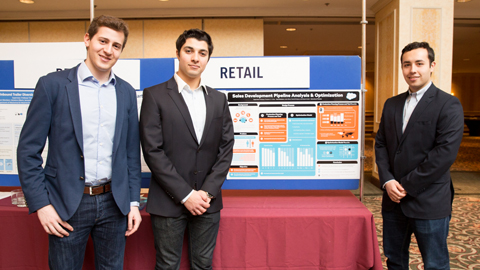
Whether it’s an app to help patients navigate Toronto General Hospital, better planning tools at Salesforce.com, or a machine that throws the elusive knuckleball, this year’s MIE Design, Research & Innovation Showcase was overflowing with ingenuity and new ideas.
On April 3, fourth-year students from the Department of Mechanical & Industrial Engineering (MIE) shared 67 capstone projects with faculty, alumni and the public. The event marked an end to eight months of collaboration between students and many industry and research partners.
This year’s showcase included five projects that were part of a cross-cultural branch of capstone – three from MIE and two from Peking University (PKU) in Beijing, China. Four faculty and 16 students visited PKU last fall, while Chinese students had an opportunity to visit Toronto and present alongside their MIE teammates this month.
Here are three highlights from the 2014 showcase:
An industrial engineering approach to sales tools

Students Julian Brais (IndE 1T3 +PEY), Tarek El Fedawy (IndE 1T3 + PEY) and Kazem Kutob (IndE 1T3 + PEY) presented their project, developed in collaboration with leading technology company, Salesforce.com – which offers companies cloud-based software to best connect with their customers, partners and employees.
“Factories produce what’s needed in a given time,” said Kutob. “So, we asked, ‘What if the sales team represented machines?’”
The first phase of their project resulted in a production planning tool to accommodate scheduling between Salesforce’s marketing and sales departments. The team took into account planning and scheduling variables to develop a customized tool that can help both groups visualize their impacts on each area on a monthly basis.
Using available data from sales calls and staff shadowing, the team also created a best practices model for the sales department managing leads.
“This was something Salesforce wanted to achieve, but didn’t know how to approach,” said El Fedawy. “Because we came to this project with an industrial engineering background, we were able to apply the optimization modeling we’ve learned in our program.”
Salesforce.com is rolling-out the planning tool out across their sales and marketing teams globally, starting in North America and Australia.
Helping patients and their families navigate hospitals
 Undergraduates Jieling Yan (IndE 1T3 + PEY), Andy Lin (IndE 1T3 + PEY), William Kwok (IndE 1T3 + PEY), and Sherry Hou (IndE 1T3 + PEY) partnered with Toronto General Hospital (TGH) to find their way through developing a mobile app.
Undergraduates Jieling Yan (IndE 1T3 + PEY), Andy Lin (IndE 1T3 + PEY), William Kwok (IndE 1T3 + PEY), and Sherry Hou (IndE 1T3 + PEY) partnered with Toronto General Hospital (TGH) to find their way through developing a mobile app.
TGH directors were struggling to develop wayfinding maps and signage for the hospital. The process had yet to find an efficient or effective solution, so the industrial engineering students designed a smartphone app to help patients and their families navigate the hospital.
To help determine the most popular areas in the hospital’s first three levels, the students met with the wayfinding committee, and then surveyed patients and hospital volunteers. The resulting app can be used upon arrival at the hospital or prior to somebody’s visit.
“The user-interface – to which applied a lot of our learning from our human factors courses – is just the beginning,” said Kwok. “Now, we want to help develop more of the back-end, the database, to support the functionality of the app.”
Engineering the knuckleball
Professor David Sinton (MIE) has always wondered whether a knuckleball pitch can be perfectly repeated.
A knuckleball is the most difficult ball for players to hit. Typically grasped by the finger nails and raised knuckles, it’s not thrown by many major league players, with Toronto Blue Jays’ R.A. Dickey among the few. A perfect knuckleball can take years to master.
“Mystery has always surrounded the knuckleball pitch,” said Professor Sinton. “Generating truly repeatable and controllable motion from the knuckleball, mechanically, would make history.”
The mystery of the knuckleball is found partly in the baseball’s seams, which create an uneven drag on the knuckleball’s flight path. This makes it move in seemingly erratic directions. Ideal knuckleballs only take a half revolution from the pitcher’s mound to the plate.
Students Martin Cote (MechE 1T3 + PEY), Alex Gordon (MechE 1T3 + PEY), Jessica Tomasi (MechE 1T3 + PEY) and Queenie Yuan (MechE 1T3 + PEY) set out to design a knuckleball-pitching machine.
Building their prototype with PVC tubes, motors, an actuator, sensors and a used pitching machine, the team used slow-motion cameras and radar guns to test the ball’s orientation, spin, speed and flight path. They also took particular note of the ball’s seam positioning.
While the machine successfully throws breaking and wobbling knuckleballs, they’re still striving for repeatability. The team developed their machine in-house using the department’s fabrication lab.
The projects delighted many clients, including Shahan Parshad, Saleseforce’s Director, Sales Strategy & Operations: “The MIE capstone design project was of huge benefit to our company, to me professionally, and to the students. It’s a no-brainer for all parties involved, and we look forward to continuing our relationship with the capstone program for years to come.”




